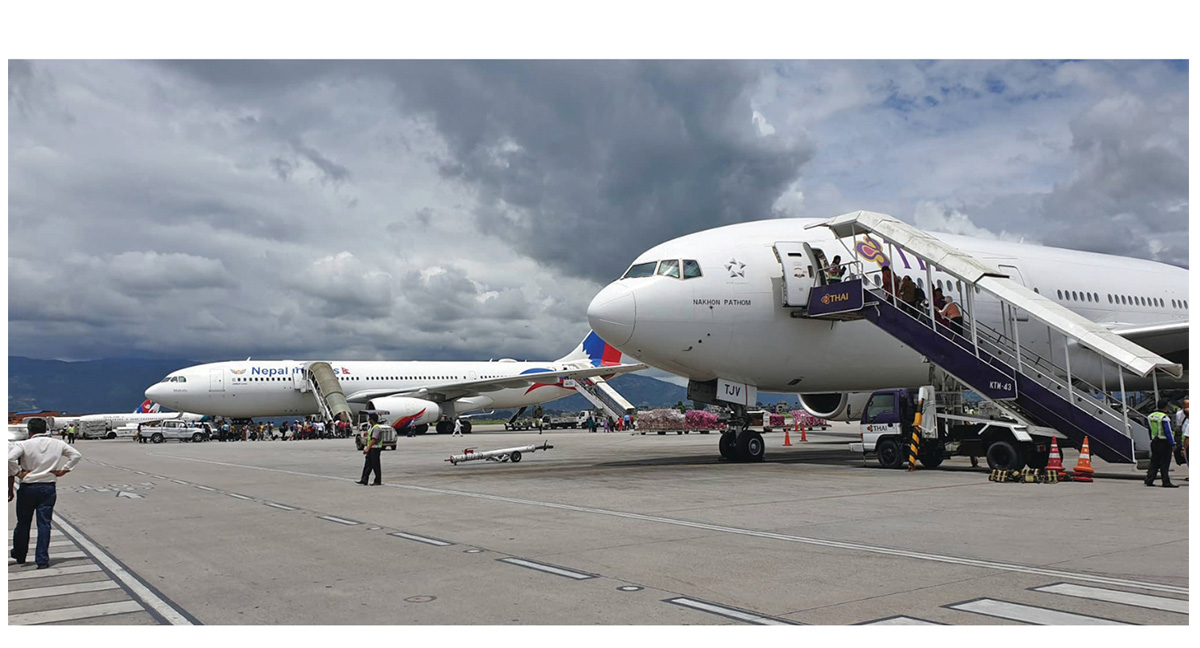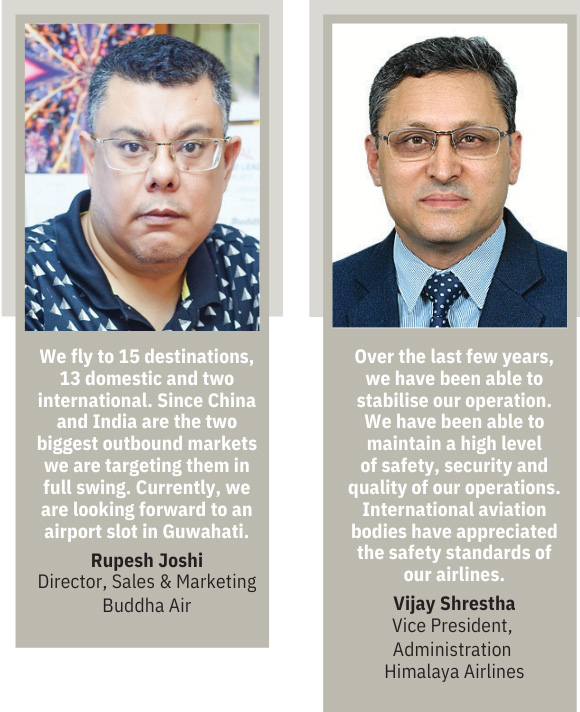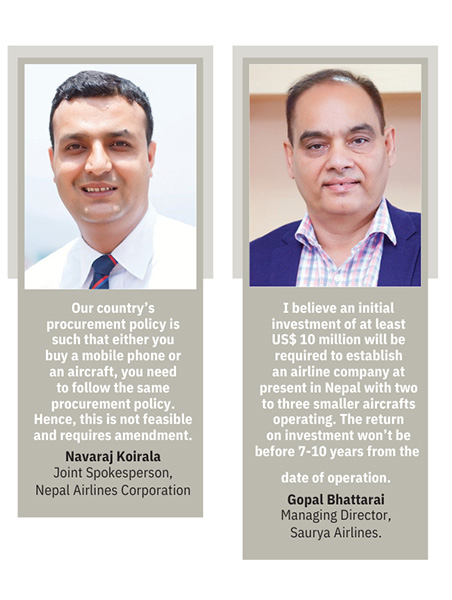
The history of aviation in Nepal dates back to 1949 with the landing of a Beechcraft Bonanza carrying the then Indian ambassador to Nepal. The first jet aircraft to land at Tribhuvan International Airport was a Lufthansa Boeing 707 in 1967. Five years later, then Royal Nepal Airlines commenced jet operations with Boeing 727 aircraft. Nepal adopted a liberal sky policy in 1992 and since then it has been gradually pursuing an open sky policy in accordance with the Civil Aviation Policy 2006. With new players in the market and an increase in smaller aircrafts, the competition is cut-throat. Business 360 digs into the economics of Nepal owned airlines and how it differs from its higher-priced peers, the legacy airlines.

Air Travel: Then and Now
In the old days, when Nepal Airlines primarily catered to affluent and business travellers, flying was an experience in itself. Airline travellers were pampered a lot, plied with food and wine on flights that were seldom full, which frequently allowed one to stretch out on the adjacent empty seat.
“Until the late 70s, the International Air Transport Association controlled the airfares, and airlines could afford to entertain passengers with five-star meals with Scotch, wine, champagne and what not. Also in the late 80s, NAC acquired two highly advanced B757 jets, which made it possible to take NAC’s reach all the way to London, Paris, Frankfurt and Osaka,” says Navaraj Koirala, Incharge Agency & Interline Commercial Department, NAC.
Those golden years of airlines started declining after deregulation was decreed by the U.S. President Jimmy Carter in 1978. Another jolt came when the Low-Cost Carrier was launched in Europe in 1995 and Asia in 2001. Many airlines, including national flag carriers of many countries, have suffered subsequent losses. Many governments saved their flag carriers by injecting billions of dollars.
The only silver lining of this fiasco in NAC was the increased volume of ground-handling business due to the entry of more and more foreign airlines at TIA. “Policy-makers and decision-makers in high positions did not bother to analyse what went wrong with the national flag carrier, which was once considered the best airline in South Asia,” informs Koirala.
Air travel nowadays is characterised by inevitable delays, lengthy security procedures, noisy cabins and few freebies in the food and entertainment category.
The Rise of Domestic Carriers
After the national carrier, Buddha Air was the first domestic carrier which commenced operations in 1997 with a mountain flight to Mount Everest using a brand new Beechcraft 1900D. Today the number has increased to seven airlines operating within the country, Saurya and Himalaya Airlines being novices in the industry. “Himalaya Airlines is in its infancy. Over the last few years, we have been able to stabilise our operation. We have been able to maintain a high level of safety, security and quality of operation. International aviation bodies have appreciated the safety standards of our airlines,” says Vijay Shrestha, Vice President, Administration, Himalaya Airlines.
All the aircrafts in operation across the world are either purchased or leased as per the national procurement policy. “Our country’s procurement policy is such that either you buy a mobile phone or an aircraft, you need to follow the same procurement policy. Hence, this is not feasible and requires amendment,” says Koirala. Leasing an aircraft is the practice followed by many airlines; whereas, in our country, almost all the aircrafts are bought. “Leasing comes with an additional tax of 10% in our country and to save on this, most airlines move towards purchasing,” adds Rupesh Joshi, Director, Sales & Marketing, Buddha Air. Also to cut down the cost and stay at par with usability, all domestic carriers of our country purchase aircrafts which are 7-9 years old. “We cannot afford new aircrafts. Hence we go for mid-life ATR aircrafts which cost us between US$ seven to 10 million. The cost of these aircrafts are determined by their engine hour which runs for 10,000 hours. Also in our country, the flight operational hours are just seven hours a day so these mid-life aircrafts fit best,” Joshi claims. The world’s top airlines do not use aircrafts after 6-7 years of operation since they operate for more than 15 hours a day.
On the other hand, NAC bought four new aircrafts within a span of three years at Rs 35 billion. “We bought two new Airbus A320 in 2015 and another two Airbus A330 in 2018,” reveals Koirala. Currently, NAC has four Airbus for the international market. For the domestic market, it has nine aircrafts out of which three have been granted by the Chinese government and three have been purchased from China. The current investment in domestic aircraft is Rs 2 billion.
Being in the industry for the past four years, Saurya Airlines has been competing with other domestic carriers with only two aircrafts. “Having a limited number of aircrafts has been our major challenge at present since we are not able to render wide and ample service in the trunk-route sector. Also, the CRJ 200 is a high fuel consumption aircraft which is another obstacle to compete with low fare tickets,” highlights Gopal Bhattarai, Managing Director, Saurya Airlines. CRJ 200 aircraft is a Canadian Jet aircraft, manufactured by the company, Bombardier. Saurya Airlines is soon inducting turboprop aircraft in its fleet with the addition of a few ATR 72 aircrafts.

Financial Implications
Fuel costs comprises one-third of every airline’s operational cost; one-third is the administrative and maintenance cost, and the remaining amount is the revenue. Following a price reduction, the price of aviation fuel cost hascome to Rs 94.50. The state-owned monopoly had been selling aviation fuel at Rs 104.50. “Nepal has the highest aviation fuel cost,” says Shrestha firmly. The maintenance cost is another huge expenditure. “It is categorised into scheduled and unscheduled model. Under the scheduled model, every aircraft requires a check after 3000-3500 hours of operation. Light maintenance between seven-12 years of its operation and post 12 years it is under high maintenance. The unscheduled maintenance can arise at any moment which costs millions to the airline,” says Joshi.
Aircrafts are also backed by insurance. For instance, in the history of Buddha Air, insurance was claimed twice covering a major air crash of the airlines a few years ago.
Though the airlines run on cash flow, they are burdened with heavy loans. “We are not in the position to make profit currently especially in the domestic sector. We inject money from international to domestic to keep it running. One of the key factors of running at loss in the domestic market is the low fare we need to price ourselves at. At times the fare does not even cover our fuel price but we have to operate being a government entity,” shares Koirala. Talking about the international market, he adds, “Currently, we are going through a serious financial crisis because we have purchased four new aircrafts within a span of three years. This costs us Rs 35 billion in one go. No international airline purchases aircrafts on such huge budgets at once. Further, the interest rate associated with this is almost 10-11% which sums up to Rs 4 billion a year.” The national flag carrier has the equity of Rs 50 billion but the capital invested by the government is only Rs 250 million. Talking about domestic carriers, Buddha Air has a loan of more than Rs 1 billion.
“I believe an initial investment of at least US$ 10 million will be required to establish an airline company at present in Nepal with two to three smaller aircrafts operating. The return on investment won’t be before 7-10 years from the date of operation,” highlights Bhattarai.
Comparing the statistics of passengers for air travel in the year 2017 and 2018, the figures show an increment. NAC saw an increment of 92,737 in 2018 from a total number of 400,436 international passengers travelling in 2017. Buddha Air claims to see a rise of 169,813 in the year 2018-19 which sums to 493,173 passengers. Himalaya Airlines served 241,384 passengers in 2018 which was 10,720 passengers more than 2017. And Saurya Airlines had flown 106,429 passengers in 2018. The booking pattern of all these airlines observed 10-15% through the sales counter of the respective airlines, 20-25% through OTAs and the rest through travel agents. “The OTAs are slowly capturing the market,” says Bhattarai.
Besides flying passengers, airlines also earn through cargo. While Buddha Air carried 1,214,478 kgs in the year 2018-19 which is 17,251 kg more than 2017, NAC carried 608,350 kgs more in 2018 in comparison to last year which was 1,181,247 kgs.
Regions
Nepal has signed bilateral air service agreements and memoranda of understanding with 39 countries since 1963. However, the national flag carrier has experienced a decline in its operations over the last two decades with its international flights limited to only eight destinations, down from 12. “Our market share has dropped down to 3-4% due to lack of aircrafts. However, we have plans for seven new destinations in the coming years. We have plans to fly to Kolkata and Hyderabad. We will be flying to Japan by this August; Guangzhou by the end of September or October, and South Korea by January 2020. Further, we plan to add Saudi Arabia as well,” informs Koirala. With operations to six international destinations, Himalaya Airlines is trying to open up new routes in the neighborhood destinations. “Our efforts to secure permits from host governments to operate flights in and out of their airports are still in progress,” says Shrestha.
The airline focuses on two markets: tourist and manpower. While Buddha Air targets tourists, Himalaya Airlines concentrates on manpower. “We fly to 15 destinations, 13 domestic and two international. Since China and India are the two biggest outbound markets we are targeting them in full swing. Currently, we are looking forward to an airport slot in Guwahati,” says Joshi. After 22 years of operation, the airline is also planning to shift its base to Pokhara International Airport to tap into the Chinese and Indian markets. It also plans to lease Airbus A320 for the operation.
All Nepal owned airlines consider October-November as the peak travel season and tend to increase flight frequency, while June-August are observed as off-season. To practice cost-cutting, airlines reduce the flight frequency then. “Bangkok, Hong Kong and Japan will run at loss during the off-season. It will have 60-65% seat capacity wherein the industry follows 75% as the breakdown. For Indian and Middle Eastern markets we don’t observe any off-season. The seat capacity is more than 90% here. We have increased frequency from seven to 14 flights a week to Delhi. And we have requested for slots in Delhi Airport and hopefully, we will fly 21 flights a week soon,” states Koirala.
Nepal tourism industry has been exerting effort to overcome seasonality since quite some time now, agrees Shrestha. “There were promotional campaigns, with a slogan, ‘Nepal for All Seasons’. Hopefully, we will be able to largely reverse the seasonality issue soon in the future,” he tells.
Being blacklisted to fly to European Skies has also been a huge drawback. “The International Civil Aviation Organisation has removed Nepal from its safety list. Nepal’s aviation sector was listed on the significant safety concern (SSC) in July 2013. Currently, the government is working to persuade the European Commission (EC) to lift the order that has barred Nepali airline companies from flying in the skies of major European countries,” informs Bhattarai.
Infrastructure
For a land-locked country like Nepal, air transportation has been a blessing as far as global connectivity is concerned. There are 56 airports in the country; 50 have been fully built and six are under construction. Twenty-six international airlines compete for ever-increasing air passengers through the one airport, Tribhuvan International Airport. “Although there are five exit points: Bhairahawa, Biratnagar, Kakarbhitta, Janakpur and Mahendranagar for international airlines, Simara is the only entry route for aircrafts flying into Nepal. It is used by almost all airlines and has been suffering from air traffic congestion,” says Shrestha.
“Tribhuvan International Airport is being utilised 300 times more than its capacity. Eight years back we could operate six flights from a single aircraft and today even four is difficult,” adds Joshi.
Nepal’s second international airport in Bhairahawa, the birthplace of Lord Buddha, is expected to come into operation by the end of 2019. Another international airport in Pokhara is expected to come into operation by mid-2021.




-1765706286.jpg)
-1765699753.jpg)

